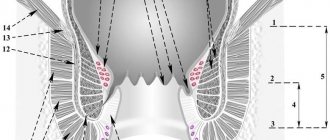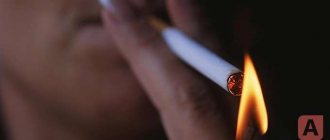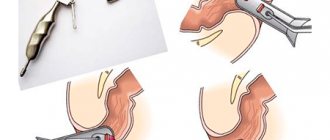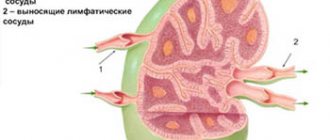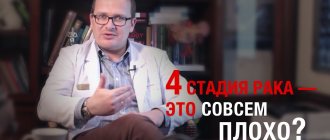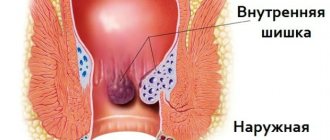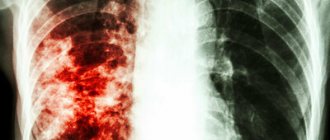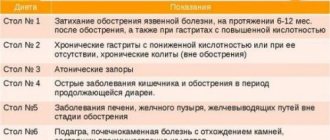Hemorrhoids are a disease that occurs in people of any age, but most often this problem is encountered by patients aged 35-55 years. The symptoms of the pathology are very unpleasant and cause significant inconvenience.
In the early stages, manifestations of the disease may cause minimal discomfort, but sooner or later an inflammatory process develops, which is accompanied by bleeding from the anus, burning and prolapse of nodes from the anus. Approximately every 10th person encounters these signs, and in the general structure of coloproctological diseases, hemorrhoids are in the leading position and account for up to 41% of all diseases of the colon.
The coloproctology department of the Federal Scientific and Clinical Center of the Federal Medical and Biological Agency of Russia provides highly qualified care for many diseases of the large intestine. The main emphasis in the treatment of hemorrhoids is on surgical interventions - high-tech operations are performed even in the most severe forms of the disease. Contact us for help, we will conduct a comprehensive examination, and, if necessary, remove hemorrhoids.
What is hemorrhoid surgery?
There are four stages of disease development:
- First stage. Characterized by bulging nodes and periodic bleeding.
- Second stage. The nodes increase, prolapses are added, but the nodes can be straightened yourself.
- Third stage. The nodes increase in size, prolapses are added, but the nodes can no longer be straightened on their own.
- Fourth stage. Constant loss of bleeding nodes.
In the initial stages of hemorrhoids, when the hemorrhoids are not very pronounced and do not cause significant discomfort, conservative treatment using tablets, rectal suppositories, and ointments is possible. In most cases, this method of treating nodes does not get rid of the root cause of the disease. For this reason, surgery is recommended for hemorrhoids.
Surgeons at our coloproctology department at the clinic of the Federal Scientific and Clinical Center of the Federal Medical and Biological Agency in Moscow use innovative, minimally invasive techniques when removing hemorrhoids. These methods are:
1. Infrared photocoagulation. This is a type of laser surgery, during which the leg of the node is cauterized. The high temperature of the laser radiation “evaporates” the tissue of the node, thereby eliminating the root cause of hemorrhoids - dilated veins. Our clinic uses equipment from the American company Reedfeed. The effectiveness of this technique in the treatment of hemorrhoids at an early stage is almost 80%, which is a very good result.
2. Sclerotherapy. This technology involves the introduction of a special sclerosant substance into the hemorrhoid. Due to their special chemical properties, these substances, when introduced into a node, cause collapse of blood vessels (veins) and their sclerosis (overgrowth), which is accompanied by a decrease in the volume of the node and prevents them from becoming inflamed in the future. The effectiveness of this technique is about 85%, with its help you can get rid of a maximum of 2 nodes at once.
3. Ligation with latex rings. With this method, a latex ring is placed on the stem of the hemorrhoid, which prevents blood circulation. As a result of a disturbance in the blood supply, a gradual death and subsequent removal of the weakened node occurs - after 1.5-2 weeks it disappears on its own, and in its place a small stump remains, which does not cause any discomfort to the patient. Our clinic uses latex rings and equipment for applying them from Kare Storze. The effectiveness of this method of treating hemorrhoids at stage 3 is 70%.
4. Cryodestruction. This technique for removing hemorrhoids involves freezing them with liquid nitrogen and subsequent destruction (used extremely rarely).
5. Desarterization of hemorrhoids or embolization of branches of the rectal artery. During this procedure, catheterization of the superior rectal artery is performed. Through a catheter, several Teflon balls up to 0.6 mm in size are introduced into the lumen of the specified blood vessel. These balls clog the small arteries that feed the nodes, resulting in their hardening. In this case, there is no need to remove the nodes themselves.
By wisely choosing one of the listed methods, you can help solve the problem for each patient. At the same time, the price for hemorrhoid removal in our clinic using minimally invasive techniques is affordable for any category of patients, and their use is preferable due to the lower number of complications.
Methods of surgical treatment
- Desarterization of hemorrhoids - during the procedure, large vessels feeding the venous expansion are ligated. The pathological area, having lost its power source, gradually dies. If required, after disarterization, mucosal lifting and mucopexy are performed - additional suturing of the sagging mucous membrane with a special thread and tightening of the sutured area.
- Laser destruction (vaporization) is a minimally invasive method of removing pathological venous expansion under the influence of a thermal laser beam. The laser acts only on the affected tissue, heats the node, and evaporates the liquid from it. A small scar remains at the site of the removed extension, which prevents relapses. The advantage of the method is that the heat beam seals small blood vessels, this will avoid postoperative bleeding and rough scars on the mucous membrane.
- Thrombectomy from an external hemorrhoid with a laser - removal of a blood clot from the affected area of the vein, sometimes involving the venous wall. The laser machine allows for targeted surgery. The laser beam simultaneously seals the walls of the vein.
Methods of radical surgical treatment of hemorrhoids
Despite the existence of minimally invasive surgical methods for the treatment of hemorrhoids, classical radical hemorrhoidectomy or the Milligan-Morgan operation in various modifications remains in great demand. During it, a radical removal of the three main groups of internal nodes of the hemorrhoidal plexus is performed, as well as excision of existing external nodes.
The Milligan-Morgan operation is considered the optimal solution to the problem - it cures 100% of patients with stage 3-4 of the disease. However, many patients have questions: how much does this operation cost and why is it better than others? Note that the price for this operation for hemorrhoids is slightly higher, since the patient requires hospitalization in the department for several days. There are other types of hemorrhoidectomy: according to Longo, Parks, Ferguson. The doctor decides which operation to perform depending on the clinical situation.
During the surgical operation, our specialists use high-tech techniques, such as:
- ultrasonic or radio wave scalpel;
- laser installations;
- linear staplers for fabrics;
- Liga-Sure device.
By the way, the price of surgery for hemorrhoids does not change depending on what equipment the doctor uses - the specialist’s task is to perform an effective operation without complications in conditions of maximum comfort for the patient.
How to prepare for hemorrhoid surgery
Preoperative examination includes an examination by a doctor and a number of laboratory and instrumental examinations, among which the following are mandatory:
- blood and urine tests (general);
- biochemical blood test;
- coagulogram;
- determination of blood group and Rh factor;
- blood test for antibodies to HIV and hepatitis viruses.
A few days before the planned date of surgery, the patient should adhere to a special diet with a minimum of foods that stimulate peristalsis. On the eve of the operation and 2-3 hours before it, you should do a cleansing enema. You should definitely tell your doctor if you are taking any medications; you should evaluate the possibility of taking them during and after surgery.
What is included in the cost of hemorrhoid removal surgery?
Treatment prices depend on several factors. Fundamental among them is the specific method of surgical intervention. How much a specific operation costs can be clarified during a consultation with a doctor, who will explain the features of a particular treatment method, warn about possible complications and talk about the features of the postoperative period.
The price includes a consultation with an anesthesiologist and pain relief. Our clinic uses all modern techniques, from local anesthesia to general anesthesia.
If there are indications, other coloproctological operations can be performed in our clinic, such as:
- excision of the epithelial-coccygeal tract;
- excision of perianal fissures;
- excision of rectal fistulas;
- rectopexy (surgery for colon prolapse) and many others.
Diet after hemorrhoid surgery
A balanced diet after hemorrhoidectomy allows patients to receive the substances necessary for recovery without experiencing problems with bowel movements. Products that can irritate the intestines and cause gas formation should be completely excluded. Food should not contain coarse, indigestible particles that can injure postoperative wounds in the rectum.
It is recommended to eat up to 6 times a day in small portions. You need to consume up to 2 liters of water per day. The basis of the diet for three weeks after surgery should be cereals and vegetables. The menu must include:
- porridge from buckwheat and millet;
- chicken or lean beef broth;
- green vegetables and leafy crops;
- cauliflower and broccoli;
- pumpkin;
- beet.
It is better to cook them by stewing and boiling, but under no circumstances fry them. At first, you should do without seasonings and spices, adding only a little salt to your food.
If the above measures are followed, the recovery period after hemorrhoidectomy is easy and without complications. Full return to work occurs approximately 5 weeks after surgery.
Postoperative period
Rehabilitation after removal of hemorrhoids is the most important stage in the patient’s life. After any operation, efforts should be made to prevent complications and accelerate tissue healing. In the postoperative period, we prescribe a protective regime, a strict diet and certain medications.
The following rules must be observed:
- hunger on the first day after surgery (drinking liquids is allowed);
- a diet that excludes foods with a gas-forming effect - prohibited: black bread, legumes, milk, cabbage;
- It is forbidden to eat pickled foods, pickles, spices;
- alcohol is excluded;
- the diet is enriched with fermented milk products, it is recommended to consume a large volume of liquid - at least 1.5-2 liters per day;
- heavy physical labor is limited for at least 3 weeks after surgery;
- careful personal hygiene is required.
If coloproctological diseases occur, contact the Federal Scientific and Clinical Center of the Federal Medical and Biological Agency of Russia in Moscow - we will help solve any health problems.
Physical activity after ligation of hemorrhoids
The manipulation itself is minimally invasive and painless, which is performed on an outpatient basis under local anesthesia. After ligation of hemorrhoids, their blood supply is stopped and after 1-2 weeks they die. These formations are removed from the body naturally during the act of defecation.
In place of the eliminated nodes, a scar of connective tissue is formed. During the healing of the rectal mucosa, minor pain is possible after ligation, a feeling of pressure in it, a false urge to defecate (tenesmus), which can be relieved within 2-3 days with painkillers.
In order for the rehabilitation period after ligation of hemorrhoids to go smoothly, it is necessary to follow a number of recommendations, including limiting physical activity, which combine:
- lifting weights (no more than 3-5 kg);
- cycling or exercise on an exercise bike;
- playing football, tennis, basketball;
- various types of struggle;
- fitness classes;
- swimming;
- static and dynamic physical exercises associated with tension in the abdominal muscles.
An early recovery period of 1-2 weeks excludes any physical activity, since rejection of nodes may be accompanied by slight bleeding after ligation. This phenomenon is short-lived and goes away on its own.
In order for recovery to proceed actively and without complications, the patient is strictly prohibited from taking a sitting position. The duration of the ban is determined by the doctor based on clinical data.
Active sports are allowed a month after removal of the nodes and consultation with a proctologist. It is necessary to expand the range of physical activity in doses and gradually so that the body can adapt after the intervention.
